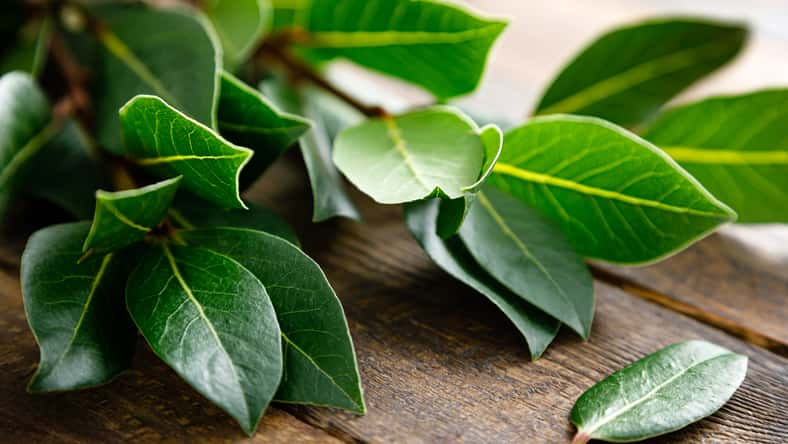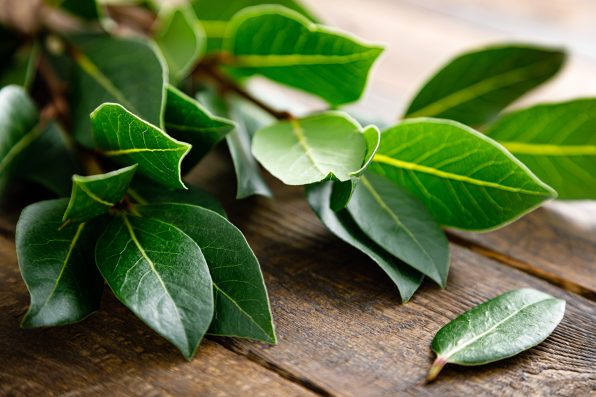Here’s How To Plant And Care For Bay Laurel, The Aromatic Staple In Kitchens Worldwide

Bay Laurel, scientifically known as Laurus nobilis, is more than just an attractive small tree or shrub; it’s a staple in kitchens worldwide.
Its glossy, dark green leaves are not just for show– they’re the famous bay leaves used to flavor soups, stews, and sauces.
Can you imagine plucking a leaf or two for your cooking directly from your own plant? What a dream!
And if that’s your goal, here’s everything you need to know about growing and caring for this powerful, aromatic plant.
Planting Bay Laurel: Laying The Foundations
Starting your Bay Laurel journey does require a bit of planning. First, choose a sunny location as it thrives in full sun, mimicking its Mediterranean origins. And if you’re in a cooler climate, consider planting it in a pot for easy movement indoors during harsh winters.
Spring planting is ideal, giving the plant ample time to establish itself. Also, if you’re opting to plant in a pot, ensure that it’s large enough to accommodate growth and has good drainage holes.
Optimal Growing Conditions: Sun, Soil, And Water
While Bay Laurel is adaptable, it also favors certain conditions. This pant prefers well-draining soil– a mix of potting soil, sand, and peat is ideal.

Sea Wave – stock.adobe.com – illustrative purposes only
Also, be sure to water the plant regularly, allowing the soil to dry out slightly between waterings. Overwatering can lead to root rot, so it’s crucial to find a balance.
Lastly, during the growing season, a balanced, slow-release fertilizer will support its growth. Remember, this plant loves the sun but can tolerate partial shade.
Pruning And Harvesting: Techniques And Tips
Pruning your Bay Laurel not only keeps it in shape but also ensures a healthy and productive plant. You can start by removing any dead or damaged branches, which helps prevent disease. Then, begin shaping your tree.
If you’re aiming for a denser bush, regularly trim the longer branches. For a tree shape, encourage growth upwards by trimming lower branches. Just remember that you should never remove more than one-third of the plant at a time to avoid stressing it.
When it comes to harvesting, the best time is in the morning after the dew has dried. Select mature leaves, which are typically larger and have a deeper color, and snip them off with a clean pair of garden shears– leaving a small portion of the stem intact.
To dry them, lay the leaves flat on a paper towel in a warm, airy spot out of direct sunlight. Once they’re crisp to the touch, you can store them in an airtight container away from light. Dried bay leaves have a more concentrated flavor and can be stored for months.
Tackling Common Problems With Bay Laurel
Bay Laurel, while hardy, can face some challenges. First, yellow leaves often indicate overwatering or a nutrient deficiency, and to address this, you can check the soil’s moisture level and adjust your watering habits accordingly.
If the yellowing persists, a balanced fertilizer might be necessary to replenish essential nutrients.
Brown leaf edges, on the other hand, typically point to underwatering or too much direct sunlight. So, ensure the soil remains evenly moist, particularly in dry conditions, and consider relocating your plant to an area with filtered light to avoid leaf scorch.
Pests like bay suckers, aphids, and scale insects can also affect Bay Laurel. Regular inspections can help you spot these pests early on.
Treatments with insecticidal soap or neem oil are typically effective in controlling these pests without damaging the plant. But, in severe infestations, removing the affected areas may be necessary.
Finally, root rot and fungal diseases can also be a concern, especially in damp conditions with poor air circulation. To prevent these issues, ensure good drainage and avoid overwatering.
If there are signs of fungal disease, such as powdery mildew, you can remove affected leaves and consider using a fungicide. Or, in the case of root rot, repotting the plant and trimming away rotted roots can often save it.
If true crime defines your free time, this is for you: join Chip Chick’s True Crime Tribe
A Teacher At Her School Got Fired For Dating A Student And Eventually Got The Student Pregnant
Sign up for Chip Chick’s newsletter and get stories like this delivered to your inbox.
More About:Gardening